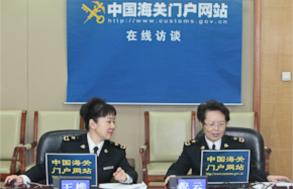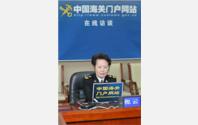 Online Interview
Online Interview
Topic: The Past & the Present of China Customs – about a Close Look into China Customs Museum
Time:10:00 AM (Thu) March 27, 2014
Special Guests: Ni Yun, Curator of China Customs Museum
The Past & the Present of China Customs – about a Close Look into China Customs Museum
[Wang Hua]: Ms. Ni, I guess our online audience may have some doubts. Why would the Customs Museum collect maps of lighthouses? Isn't this a job generally under the responsibility of port construction authorities? How come it gets associated with customs? 03/27/2014 10:18:53
[Ni Yun]: This involves the changes of customs activities and responsibilities in modern times. Maritime and port affairs used to be the responsibilities of modern customs, including the construction of navigation facilities like lighthouses and lightships, dredging channels, designating mooring berths for ships and vessels, maintaining mooring order, managing water diversion affairs and inland rivers patrolling affairs. 03/27/2014 10:19:15
[Ni Yun]: China has 5 lighthouses listed in the World’s 100 Historical & Cultural Relic Lighthouses, among which Lingao Lighthouse, Huaniao Island Lighthouse in Zhoushan and Laotie Mountain Lighthouse in Dalian were built by modern customs. The handling of maritime affairs by modern customs was very effective, and was once praised by Li Hongzhang. 03/27/2014 10:19:43
[Ni Yun]: In May 1895, Li Hongzhang returned from Shanghai to Tianjin by sea. After passing Lianyun Harbor, heavy mist suddenly clouded the sea. Li ordered the ship to pull in to shore, and set out again after the mist dissipated. But the Captain told him that the customs office had set up lighthouses and lightships along rivers and coasts, navigation in night time or foggy weather would be no problem. During the remaining voyage, Li Hongzhang paid attention and found that what the Captain said was true. He was very delighted, and upon his return to Tianjin, he immediately claimed credit for the Customs. 03/27/2014 10:20:33
[Wang Hua]: When it comes to modern customs, Li Hongzhang, this famous official in the late Qing Dynasty will be mentioned often. The netizens are curious why he inscribed the wooden tablet of “Jin Hai Xin Guan ”(New Jinhai Customs)? 03/27/2014 10:21:07
[Ni Yun]: In 1888, Tianjin Customs completed the expansion of its office buildings, and Detring, the Tax Commissioner of Tianjin Customs invited Li Hongzhang, the then Governor of Zhili and Commissioner of Trade for Northern Ports, to inscribe words on the wooden tablet. Li Hongzhang inscribed the four characters Jin Hai Xin Guan on the wooden tablet which was hung in the Tianjin Customs building. 03/27/2014 10:22:01
[Ni Yun]: His inscription is of remarkable particulars. The last stroke of “Zhang (“章” in Chinese character)” stretches through “Zao (“早” in Chinese character)”, which is quite distinctive and is known as “Stretched Zhang" later. The wooden tablet is one of the few customs tablets kept by far. During the Cultural Revolution (1966-1976), to protect this precious tablet, employees of Tianjin Customs buried it in the coal dump in the boiler room, and it was not brought to light until 1980s when the boiler room was cleaned. It reveals customs people’s strong awareness of preservation of cultural relics and their responsibility for history. 03/27/2014 10:23:11
[Wang Hua]: It is quite not easy to preserve those treasures. 03/27/2014 10:23:51
[Ni Yun]: Yes. There is another example. In 2007, we prepared to build the Guangzhou Branch of China Customs Museum. On the door board of the Canton Custom House, there was a layer of cement under the inscription of “Guangzhou Customs” which was made after 1949. When we hammered away the cement layer, the words “Canton Customs” were revealed surprisingly. It also shows the measure for preservation of cultural relics by customs officers. 03/27/2014 10:24:03
[Ni Yun]: The course of building the Museum is full of details showing customs officers’ protection of cultural relics. Let’s take an example. At that time, there were three old trees (gingko and locust trees) within the area of dislocation for the Museum. After learning this situation, with supports from departments related to planning, land, and forestry in Beijing Municipality, we asked the designer to modify the design plan so we could preserve those old trees. This little case drew attention from the news media in 2010 and was reported by CCTV and other media. Now, the three old trees have become an organic part of the Museum. 03/27/2014 10:24:42
Quick Links







